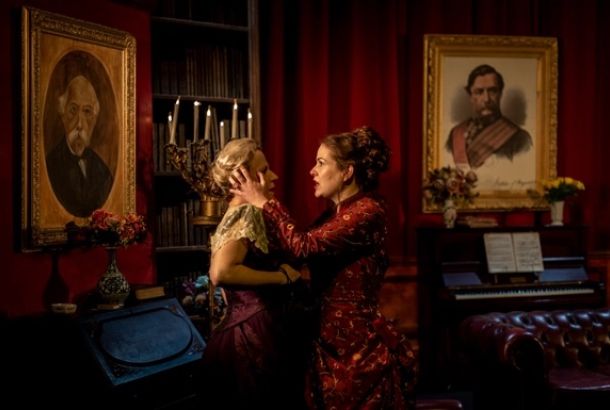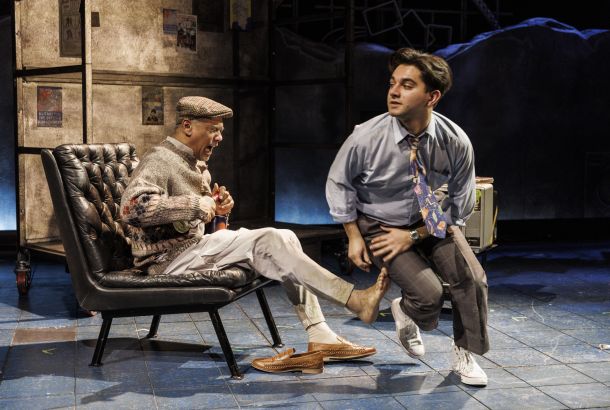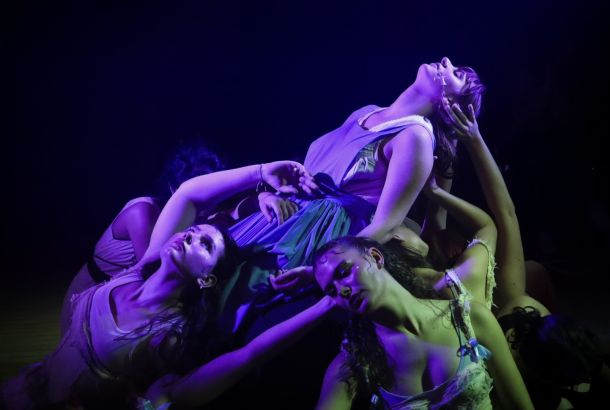The Contact Theatre describes this adaptation of Romeo and Juliet as giving ‘new life’ to the play, which has been adapted countless times. It attempts to achieve this through the use of puppetry, innovative lighting and a much shorter performance time. In cutting much of the original play, the play is able to entice a younger audience, whilst performances that span three hours or more are often daunting.
This performance focuses upon the meeting of Romeo and Juliet, wonderfully choreographed fight scenes, and ultimately the key characters deaths. The strength of this adaptation lies largely within these fight scenes, where the audience is mesmerised by the use of light in replacement of weaponry, and trance-like music. These scenes are fast paced, and exciting if not particularly emotive. It is difficult on the death of Mercutio to feel anything more than amazement; the throwing of light is bewitching but fails to convey the fury and rage of close combat.
Puppetry in Romeo and Juliet sounds exciting, and leads to a great sense of anticipation as to how these puppets will be used, and what they will look like. However, sadly, this anticipation was soon replaced by confusion. The puppets employed are operated on stage by two or more of the cast. It was hard to ignore the fact that there are so many people on stage representing so few characters. I found myself wondering which member of the cast would speak the lines, and looking to them for facial expression. Furthermore, the puppets varied vastly in style, from traditional puppets to figures that resembled Star Wars characters. This was confusing, and I was unable to comprehend which characters all of the puppets represented.
This reimagining of the infamous play was acted well, and the shorter length allows the audience to be engaged throughout. For me however, this adaptation would have been far more effective without the puppetry, it was an exciting idea but one that for me, fails to convey the raw emotion of this doomed love story.
Use of puppets = 1/5 Costume = 1.5/5 Acting= 3/5
Use of innovative lighting and props= 3/5 Music= 4/5
Overall= 2/5
Rosie Panter
The Contact Theatre is well know for staging original and innovative drama and this production of Romeo and Juliet followed the trend, bringing puppetry into the adaptation of one of Shakespeare’s most famous plays.
However perhaps the most interesting thing about the performance wasn’t the innovative use of puppets but, in fact, that the performance would have served better without the inclusion of this addition. The main problem with the use of puppets was that they seemed incongruous. Whilst half the puppets used were star wars characters the other half were simply a collection of mismatched figures. There didn’t appear to be any symbolism of the star wars characters, or particularly the puppets in general. The fact that the puppets were unable to offer any facial emotions meant your eye was drawn to the cast member holding the puppet – who more often than not was acting out the part, far better than the puppet itself was.
In fact, other aspects of the performance far outshone the use of puppets. The use of light during the fight scene which results in Mercutio’s death was a use of original stagecraft which really enhanced the drama of the moment when Mercutio was struck.
One very noticeable element of the performance was the way in which it evaded being tied to any particular contextual setting. This enhanced the comic value of the moments when the actors ad-libed without making it seem as though they were trying to drag the script into a certain direction to fit a certain context. Whether on purpose or not, the lack of definable context highlighted the play’s ability to transcend time as its ending still remains as sad for any audience today.
Use of puppets= 1.5/5 Costume= 2/5 Acting= 4/5
Use of innovative lighting and props= 4/5 Music = 3.5/5
Overall= 2.5/5
Hannah Lawrence
The prospect of seeing Shakespeare’s arguably most famous play, Romeo and Julietin the Contact Theatre, Manchester, stirred both feelings of excitement and anxiety. It appears that there is an element of fear around this play: that it should be untouched and left simply to the likes of Baz Luhrman’s 1996 film adaptation or the traditional thespians of the RSC. Therefore, it seems appropriate to award some credit to Night Light Theatre for simply undertaking such a heavy weight text.
The production was undeniably imaginative: puppets, live music, stage fighting, creative lighting, magic, choral singing and so on. The set itself, a multifunctional circular raked wooden stage, was reminiscent of the Globe, whilst creating a practical and beautiful platform for the action to take place. The music transformed moments: a highlight being the party scene, in which Romeo and Juliet meet for the first time, was effectively underscored by a folk rendition of the Shakespearean text. A perfect example of how music can be intertwined into the action to give the performance a fuller sensory impact. However there was an underlying sense that this multi-layering of production features was an attempt to distract from the mediocre standard of acting. I find it hard to comprehend that, when the theatre world is inundated with actresses, casting directors can get the role of Juliet so wrong.
Night Light Theatre had consciously edited the script by almost half, allowing the play to run for ninety minutes without an interval. This created a simplified version of the turbulent narrative and a far more accessible performance for the many sweet – eating children in the audience. I have no issue with this decision and applaud their attempt. Yet, it seemed that the play’s most important moments, such as Mercurtio’s death, were lost.
Puppets were used to replace all the adult characters in the play. This was an interesting addition to the performance and created a different visual element. The fairy-like nurse in particular was humorous, endearing and entertaining. However, despite the obvious craftsmanship, the reason for the implication of the puppets was unclear and the connection with the other characters and actors themselves was clunky. This incongruent link between narrative and creative choice was also apparent with the use of magic. Rather than violence, the youths fought with light beams to represent magical forces. Once again the creative meaning behind this, other than being visually alternative, was never made clear.
The overall impression was that Night Light Theatre was attempting to do too much whilst not really doing anything at all. There were parts which looked attractive and as if there was the opportunity to create something quite special but were never fully executed. Furthermore, there never seemed to be a reason why. Why include magic instead of violence? Why include puppets instead of actors? They had good intentions but the additions were only there for the sake of it. It is a fine line between creative ambition and delusional aspirations, and in spite of great efforts, Night Light Theatre’s Romeo and Juliet unfortunately falls into the latter.
The contact theatre is well know for staging original and innovative drama and this production of Romeo and Juliet followed the trend, bringing puppetry into the adaptation of one of Shakespeare’s most famous plays.
However perhaps the most interesting thing about the performance wasn’t the innovative use of puppets but, in fact, that the performance would have served better without the inclusion of this addition. The main problem with the use of puppets was that they seemed incongruous. Whilst half the puppets used were star wars characters the other half were simply a collection of mismatched figures. There didn’t appear to be any symbolism of the star wars characters, or particularly the puppets in general. The fact that the puppets were unable to offer any facial emotions meant your eye was drawn to the cast member holding the puppet – who more often than not was acting out the part, far better than the puppet itself was.
In fact, other aspects of the performance far outshone the use of puppets. The use of light during the fight scene which results in mercutio’s death was a use of original stagecraft which really enhanced the drama of the moment when Mercutio was struck.
One very noticeable element of the performance was the way in which it evaded being tied to any particular contextual setting. This enhanced the comic value of the moments when the actors ad-libed without making it seem as though they were trying to drag the script into a certain direction to fit a certain context. Whether on purpose or not, the lack of definable context highlighted the play’s ability to transcend time as its ending still remains as sad for any audience today.
Use of puppets = 3/5 Costume = 2/5 Acting = 2/5
Use of innovative lighting and props = 2.5/5 Music = 3/5
Overall= 2/5
Claire O’Neill
Romeo and Juliet ran at Contact Theatre between 18th and 20th October







